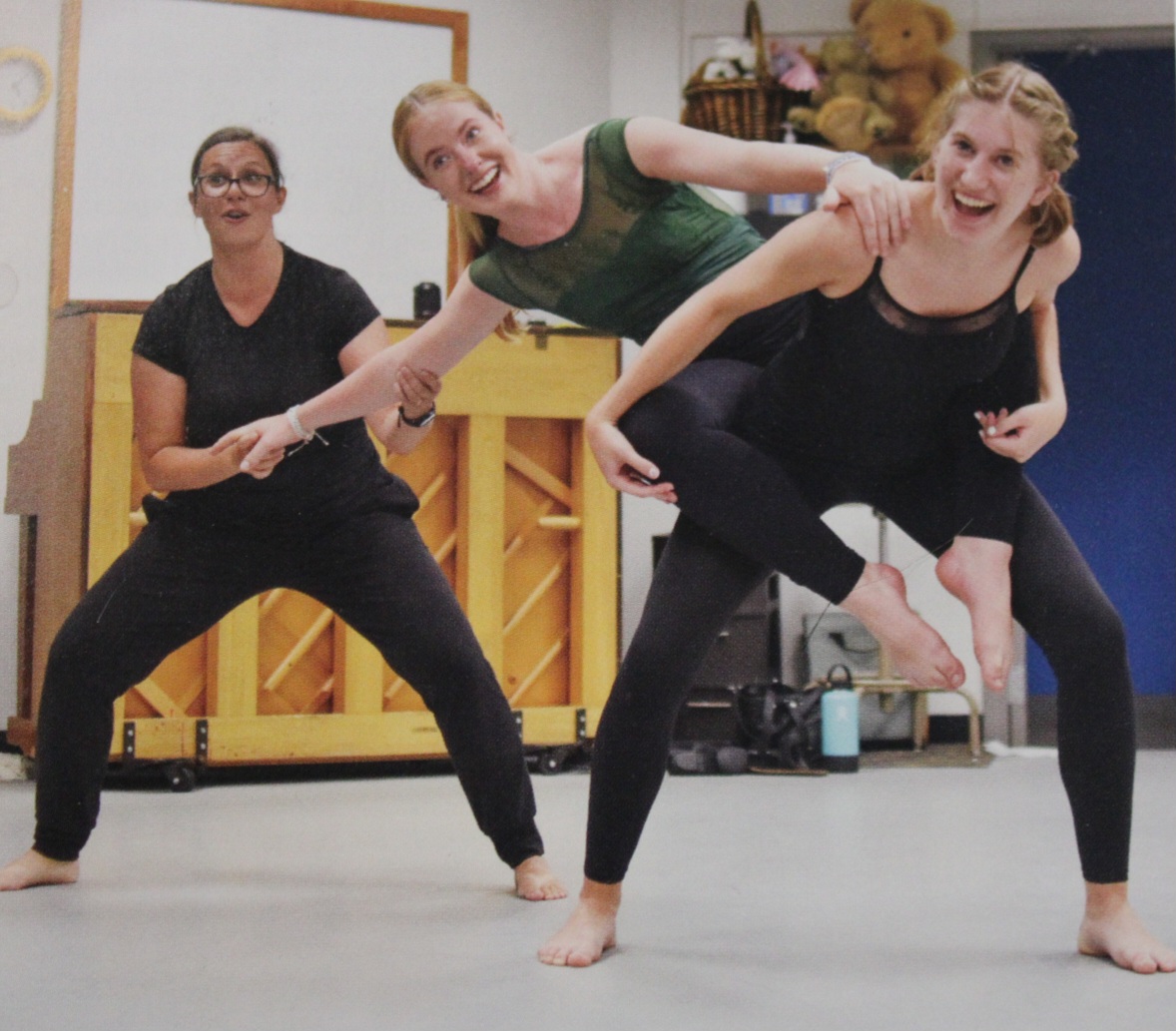Hanging from a bulletin board, next to her desk, are Arvada West High School English teacher Angela Dryer’s pointe shoes. While Dryer has always known that she would end up following the path of education for her career, she has never been willing to sacrifice her passion for dance.
She recalls the time her mom, a tap dancer and musician, who ended up becoming a geneticist, said, “I wish I would’ve done both.”
With a Bachelor’s Degree in Performing Arts, a minor in English, and a Master’s degree in English Education from Colorado State University (CSU), Dryer declares that her “heart lies in both,” teaching and dance.
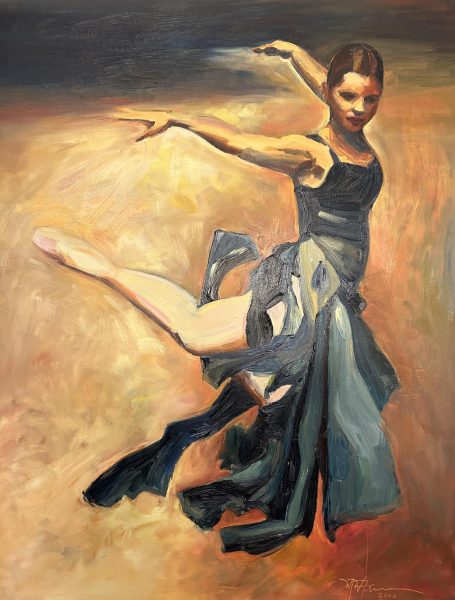
Photo courtesy of Dryer
To her students and colleagues, Dryer often embraces the fact that she is a dancer, but few know nothing more than the fact that she is a teacher who also happens to dance. They don’t know the fact that she is a Bobby G. winner and a five-time nominee. Or that one time, a photographer captured her leap in the air, then an artist made it into a painting that now is hanging inside of her house. Above all, they don’t know the rich history that lies behind her passion or the hard work she has had to put in to make her life blend together, all so she can support her two passions of teaching and dance.
“ I wasn’t willing to pick…You’ll find a way if it’s meant to be. If your life is meant to fall that way and you are passionate enough about both things, you will find a way to make that blend,” she explains.
Setting the stage for a life of dance:
Starting around the age of four, Dryer began her journey with dance, naturally following in the footsteps of her grandparents and mother who both were involved in the performing arts.
After years of taking classes in a variety of studios, “dancing anywhere from two to four hours a day,” learning different styles such as jazz, hip-hop, ballet, tap, and even participating in competitive dance, Dryer began high school in 1999 at A-West.
“When I got to high school, I was like ‘Oh I’ll use my dance to get involved.’” I’m going to try out for Poms,” she recalls. However, her instructor at the time told her that she couldn’t do both studio dance and Poms, resulting in Dryer choosing Poms over her outside-of-school dance.
Joking that she was “just a dancer in a Pom’s outfit,” Dryer quickly proved to be someone with advanced skills. As a sophomore, she got pulled up to the varsity team for the state and national competition at a time when no underclassmen were allowed to be on varsity.
While college began to roll around, Dryer was an instructor and competition judge for the National Dance Alliance, or NDA for three summers, a job that she gained through her time with Poms. During this time, she began college as a double major who wanted to make her two passions work. Despite the fact that she previously “had hated my existence” in English classes, Dryer decided to be an English teacher because “people told me I couldn’t.”
Choreography, teaching, and a little more choreography:
Interestingly enough, Dryer’s years as an English teacher, especially an AP Lang one has shifted her perspective when it comes to her choreography. What she puts on stage for her audience is her own way of storytelling, and teaching writing has only guided her craft. To her, her moves are her sentences and her punctuation. Her breath acts as her commas.
When she choreographs, her mind connects it to a rhetorical analysis. “I can see different reasons behind what I’m doing… I see all these bits and pieces and it helps me diversify what they are doing.”
Starting in college, Dryer has had opportunities to bring her choreography onto stage. Since 2003, she’s been the musical choreographer for Lakewood High School, and in recent years has gotten involved in the Arvada Center as a substitute teacher and musical choreographer during the summertime. In total, she has choreographed 20 high school level musicals, some standouts being: Something Rotten, Young Frankenstein, Hello Dolly, Jekyll and Hyde, Sweeney Todd: The Demon Barber of Fleet Street, West Side Story, Beauty and the Beast, and Les Miserables (the latter two done both at Lakewood and A-West).
If anyone can attest to the magic Dryer’s choreography can create on stage, it’s Tami LoSasso, former Lakewood High School Theater director, current Executive Director of Colorado Thespians, and longtime collaborator of Dryer’s. Describing her work as “always challenging,” and “never cliche,” LoSasso comments that Dryer, “is a fearless choreographer.”
“I would say no one is ever bored watching Ms. Dryer’s work,” she says.
Particularly in musicals, Dryer and LoSasso can agree that some of Dryer’s most memorable and best choreographic work was in Sweeny Todd, the show that Dryer won one of the biggest honors for high school theater in Colorado: a Bobby G award.
When Dryer thinks back to it, she admires her work in the production saying, “ I love that one because I brought modern dance into it, and we brought hip hop in, and we did a lot of stalls, where they would be stalling on the floor so their legs would be in the air. It was the insane asylum that I loved to choreograph because we did some weird and really creepy stuff.”
LoSasso mirrors Dryer’s appreciation, especially since she considers the show to be a “‘non-dance’ show” and notes, “What I think was particularly impressive about that show was two numbers: the movement and syncopation of “God That’s Good” where cast members stood and sat and leaned and crouched to create a really visually stunning series of movement that told the story of these over-indulgent Britons who relished the “poisoned” meat of Mrs. Lovett; and the movement in the insane asylum where she directed students to really lean into the macabre physicality of people who were deranged or who had been physically and or emotionally neglected or abused for so long their physical reflection of humanity became skewed.”

Graphic made on Canva by Chloe Rios
While the Bobby G’s are a part of gaining recognition for the performing arts in society, and Dryer’s win is a highlight as a choreographer, she dislikes the idea of competing in dance; she believes it drawbacks from the purpose of dance and what it means to be a dancer. To Dryer, a true dancer is “someone who has danced every style,” and “ someone who wants to explore the world through movement, through music, and through connection.”
That connection to her is a moment of beauty and “what dance is. It’s not about the glitter, it’s not about the prizes, it’s not about how high I can kick. It’s about the moment of true connection and being able to express and communicate whatever that message is,” she adds.
In her eyes, these elements are being lost in dancers today, and it is especially something that she notices when she substitutes at the Arvada Center. Noting that “if it is out of their norm they are uncomfortable to do it.”
Her student’s will to be pushed out of their comfort zones has never hindered her teaching, whether it be in a dance or an English matter. A teacher since 18, Dryer’s students are always being pushed to the next level and are challenged so they will grow.
She explains, “I’m somebody who when you are leaving my dancing class, you are sweating and you are dying. Same way as when you leave my English class, your brain feels like mush…When I choreograph musicals or even when I choreograph pieces at the Arvada Center, as I push my students in writing, I always choreograph above what they can do…I know they can get there.”
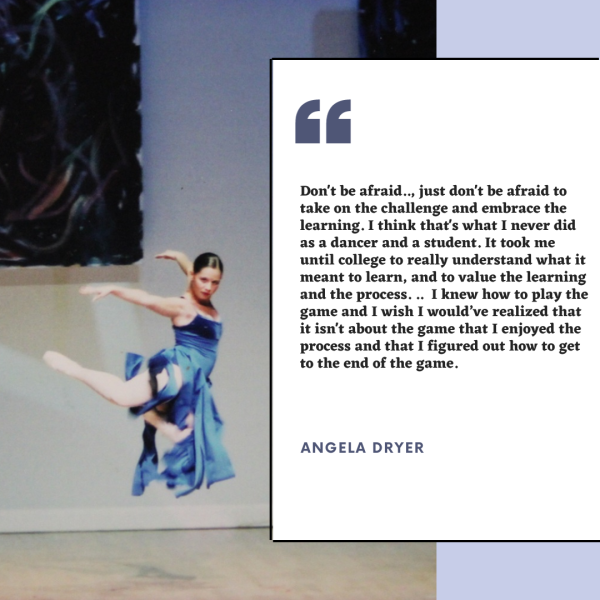
Graphic made on Canva by Chloe Rios
Or as LoSasso has observed over the years “She’s a no-nonsense director. She knows what she wants. And I admire the bar she set for countless students. She never accepted anything less than their best. She sees in her students something they don’t always see in themselves.”
Dryer is all about her students’ learning. English-wise, she wants her students to walk out of her classroom and question the world around them. She wants them to be able to “find your real voice and to feel empowered and that you do have a voice.”
Using her voice for empowerment and advocacy is something Dryer can relate to. In her years as a Pom’s dancer, she has used her voice to stand up for what she believes in and advocate for others. When she was on Pom’s as Co-captain her senior year she found herself, “butting heads with the adults,” since she wanted to change their choreography to let underclassmen dance up front at times.
“I really believed that whether you were the best or not, you should really get an opportunity.”
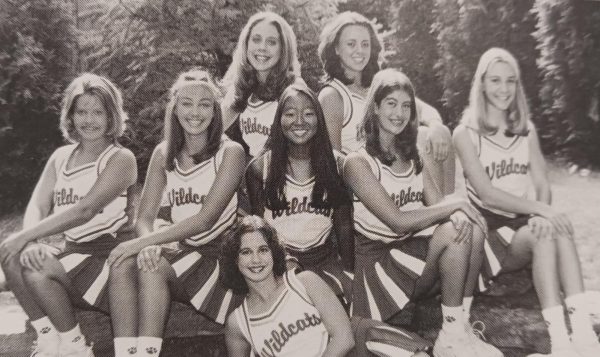
Photo courtesy of “The Claw,” Arvada West High School yearbook
Or, as a kid when she was at a studio with her former instructor, Lin, who Dryer remembers as someone who “would get a kick out of making kids cry.” She remembers “being ten or something, and she was really scolding this kid. I remember pulling them aside and being like ‘Do not let her see you cry. It gives her power.’”
As a dance teacher, Dryer’s wish is to be someone who inspires “the love of the art,” and her goal is to have her students connect to the world through their dance. From the world of dance, two names come to mind that Dryer considered to be her inspirations: her former ballet teacher Audrey Ellwood, and Martha Graham, an American dancer and choreographer.
Ellwood is someone that Dryer considers to be a role model because “she showed what it meant to be a professional dancer and a good human.”
Ellwood was someone who “could see the human in me and not just what I could do.” This shines through the day of the Columbine High School massacre. Dryer, only a freshman in high school at the time, was heading into Ellwood’s class that day. She remembers that “she just sat us down and we talked, we did not even do ballet that day.”
Ellwood was also someone whom Dryer considers an inspiration because she “was all about body and health,” likewise to Graham. To Dryer, Graham is a role model because “she was about human body and human connections and finding your breath. When I choreograph, I try to find that real within what I do and kind of try to break molds of whatever I see around me. How can I push my choreography to push those kids out of their comfort zone, out of their mold, to find their beauty, to find their connection?”
Two years ago, Dryer got hired at the Arvada Center after Julie Payne, who works with the Education department at the Arvada Center, saw her choreography at a Lakewood production. She then went on to choreograph the middle school level musical that summer Horton Hoots a Hoo, and afterwards went through a process to be hired as a substitute.
Coming out of a global pandemic, Dryer says that there is a lot of diversity in dance when it comes to age and levels. She keeps this in mind when she choreographs by thinking about “how can I change a combo across the floor so I can meet the needs of my low-level kids, and then I can meet the needs of my high kids and push them, without the low kids getting injured? It is so easy to injure yourself when you don’t have the strength or you don’t know how to do something correctly.”
For her choreography with Lakewood, one moment of Dryer pushing her students out of their comfort zone is a flip she would teach the boys on cast, a move that LoSasso likes to call the signature LoSasso/Dryer move. Dryer explains the move, “they would lay flat and their arms would be out. Other boys would stand in a row next to each other, and the boy that would lay down would run and jump in his arms. And they would hold him like a bed, and they would bounce him three times and then fly him through the air and they’d hold his arms. So he ends up being completely horizontal and perpendicular.”
“I remember being like, you have to be really serious because we could end up breaking something. I just remember so many times having to step in and being like ‘What are you doing? No!’” Or they would barely throw them and they would come down and I remember catching one of these guys… I caught him and we both kind of collapsed on the floor, but I loved it because it showed me that they were willing to trust me.”
But Dryer’s biggest wish for her dance students and the upcoming generation of dancers is for them to see the value of being a well-rounded dancer, but above all, she wants to be someone who inspires “the love of the art.” “I think people dance, but I don’t think they become full dancers until they understand the power and scope of what that movement can do,” Dryer explains.
Whether it be her references to dance movements from different cultures or her indulgence in art history that she incorporates in her work, Dryer wants her students to see the value in “taking all of the classes not just singletons. I want them to see the beauty, and understand the art of what they are participating in. Not just win the medal, just do the competition, look at my fancy costume…I want to get back to what dance is supposed to be about.”
“When we get isolated in any specific thing, we don’t understand the full scope of what we can do,” she says.
The future:
As she sits and reflects on her life as a dancer, Dryer concludes that her love for dance has never changed. Though it hasn’t changed, obstacles have stunted her ability to have time to dance, and needless to say it isn’t easy finding balance. Her job, her dance, her family, and many more aspects of who makes Dryer who she is have all been a heavy weight for her, and figuring out how to make it all work is something that she still struggles with today. At one point she says that she didn’t think her life would work out in the way that she wanted.
“I ignored that dance part of me and literally my soul suffered. That sounds weird but it did. Like mentally I wasn’t as good until one day I went and took a dance class and I was like, ‘this is what I’m missing again.’ It just helped me realize that you know, life is busy but I have to find time to do what feeds my soul which is teaching and dancing.”
Maybe what has made her life work out is her drive. Maybe it’s her passion, but regardless of what the factor is, Dryer has shown that maybe people don’t always have to choose between what they love and that making dreams come true no matter what they may be is possible if someone is willing to work for it.
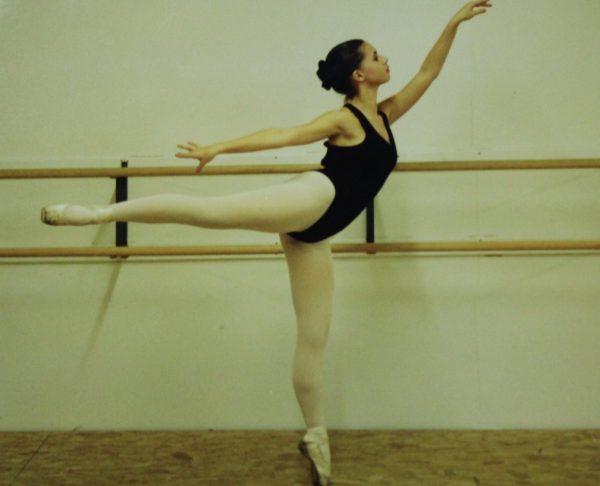
Photo Courtesy to Dryer.
Quote found in the 2002 edition of “The Claw,” Arvada West’s yearbook.
As she looks into the future, Dryer continues to be a dreamer. She wants to be someone who is a part of the conversation for a reimagined high school. She is a part of district committees to have her say in it. For her English students, she wants to get to the point where they can publish their writing, and for her daughters, she wants them to be able to explore and fail, then explore and succeed.
But for herself, she wants to step away from always sacrificing her time for others and putting herself last. Though she loves choreographing, Dryer’s wish is to take a piece of her own advice, not be afraid and terrified of embarrassment, and get back to taking dance classes for herself. And maybe in some ways, Dryer will go back to being a student, instead of always being the teacher.


